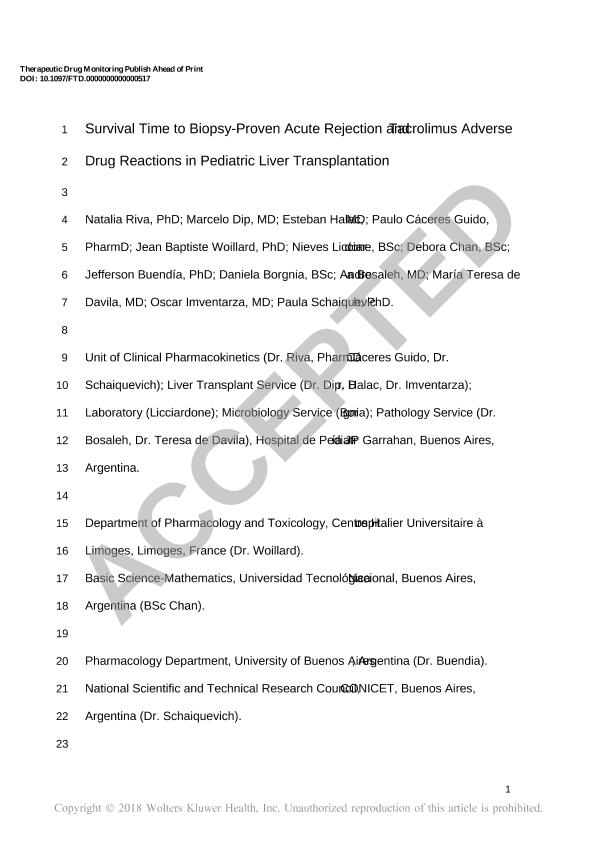Artículo
Survival time to biopsy-proven acute rejection and tacrolimus adverse drug reactions in pediatric liver transplantation
Riva, Natalia ; Dip, Marcelo; Halac, Esteban; Guido, Paulo Cáceres; Woillard, Jean B.; Licciardone, Nieves; Chan, Debora; Buendía, Jefferson; Borgnia, Daniela; Bosaleh, Andrea; de Davila, María T.; Imventarza, Oscar Cesar; Schaiquevich, Paula Susana
; Dip, Marcelo; Halac, Esteban; Guido, Paulo Cáceres; Woillard, Jean B.; Licciardone, Nieves; Chan, Debora; Buendía, Jefferson; Borgnia, Daniela; Bosaleh, Andrea; de Davila, María T.; Imventarza, Oscar Cesar; Schaiquevich, Paula Susana
 ; Dip, Marcelo; Halac, Esteban; Guido, Paulo Cáceres; Woillard, Jean B.; Licciardone, Nieves; Chan, Debora; Buendía, Jefferson; Borgnia, Daniela; Bosaleh, Andrea; de Davila, María T.; Imventarza, Oscar Cesar; Schaiquevich, Paula Susana
; Dip, Marcelo; Halac, Esteban; Guido, Paulo Cáceres; Woillard, Jean B.; Licciardone, Nieves; Chan, Debora; Buendía, Jefferson; Borgnia, Daniela; Bosaleh, Andrea; de Davila, María T.; Imventarza, Oscar Cesar; Schaiquevich, Paula Susana
Fecha de publicación:
08/2018
Editorial:
Lippincott Williams
Revista:
Therapeutic Drug Monitoring
ISSN:
0163-4356
Idioma:
Inglés
Tipo de recurso:
Artículo publicado
Clasificación temática:
Resumen
Background: Despite advances in surgical procedures and the optimization of immunosuppressive therapies in pediatric liver transplantation, acute rejection (AR) and serious adverse drug reaction (ADR) to tacrolimus still contribute to morbidity and mortality. Identifying risk factors of safety and efficacy parameters may help in optimizing individual immunosuppressive therapies. This study aimed to identify peritransplant predictors of AR and factors related to the risk of ADR to tacrolimus in a large Latin American cohort of pediatric liver transplant patients. Methods: We performed a retrospective cohort study in a pediatric liver transplant population (n = 72). Peritransplant variables were collected retrospectively including demographic, clinical, laboratory parameters, genomic (CYP3A5 donor and recipients polymorphism), and tacrolimus trough concentrations (C0) over a 2-year follow-up period. Variability in tacrolimus C0 was calculated using percent coefficient of variation and tortuosity. ADR- and AR-free survival rates were calculated using the Kaplan–Meier method, and risk factors were identified by multivariate Cox regression models. Results: Cox-proportional hazard models identified that high tortuosity in tacrolimus C0 was associated with an 80% increased risk of AR [hazard ratio (HR), 1.80; 95% confidence interval (CI), 1.01–3.22; P, 0.05], whereas steroid in maintenance doses decreased this risk (HR, 0.56; 95% CI, 0.31–0.99; P, 0.05). Forty-six patients experienced at least one ADR including hypomagnesemia, nephrotoxicity, hypertension, malignancies, and tremor as a first event. Multivariate analysis showed that C0 values 10 days before the event (HR, 1.25; 95% CI, 1.21–1.39; P, 0.0001) and CYP3A5 expresser recipients (HR, 2.05; 95% CI, 1.03–4.06; P, 0.05) were independent predictors of ADR. Conclusions: Tacrolimus C0 values, its variability, and CYP3A5 polymorphisms were identified as risk factors of AR and tacrolimus ADR. This knowledge may help to control and reduce their incidence in pediatric liver transplant patients. Prospective studies are important to validate these results.
Archivos asociados
Licencia
Identificadores
Colecciones
Articulos(SEDE CENTRAL)
Articulos de SEDE CENTRAL
Articulos de SEDE CENTRAL
Citación
Riva, Natalia; Dip, Marcelo; Halac, Esteban; Guido, Paulo Cáceres; Woillard, Jean B.; et al.; Survival time to biopsy-proven acute rejection and tacrolimus adverse drug reactions in pediatric liver transplantation; Lippincott Williams; Therapeutic Drug Monitoring; 40; 4; 8-2018; 401-410
Compartir
Altmétricas



